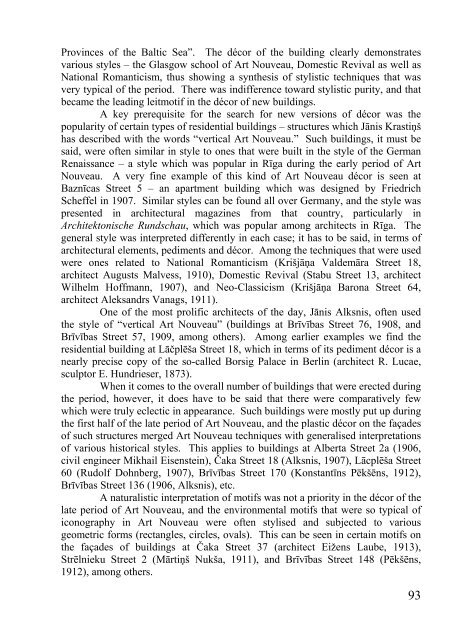SILVIJA GROSA JŪGENDSTILA PERIODA PLASTISKAIS UN ...
SILVIJA GROSA JŪGENDSTILA PERIODA PLASTISKAIS UN ...
SILVIJA GROSA JŪGENDSTILA PERIODA PLASTISKAIS UN ...
You also want an ePaper? Increase the reach of your titles
YUMPU automatically turns print PDFs into web optimized ePapers that Google loves.
Provinces of the Baltic Sea”. The décor of the building clearly demonstrates<br />
various styles – the Glasgow school of Art Nouveau, Domestic Revival as well as<br />
National Romanticism, thus showing a synthesis of stylistic techniques that was<br />
very typical of the period. There was indifference toward stylistic purity, and that<br />
became the leading leitmotif in the décor of new buildings.<br />
A key prerequisite for the search for new versions of décor was the<br />
popularity of certain types of residential buildings – structures which Jānis Krastiņš<br />
has described with the words “vertical Art Nouveau.” Such buildings, it must be<br />
said, were often similar in style to ones that were built in the style of the German<br />
Renaissance – a style which was popular in Rīga during the early period of Art<br />
Nouveau. A very fine example of this kind of Art Nouveau décor is seen at<br />
Baznīcas Street 5 – an apartment building which was designed by Friedrich<br />
Scheffel in 1907. Similar styles can be found all over Germany, and the style was<br />
presented in architectural magazines from that country, particularly in<br />
Architektonische Rundschau, which was popular among architects in Rīga. The<br />
general style was interpreted differently in each case; it has to be said, in terms of<br />
architectural elements, pediments and décor. Among the techniques that were used<br />
were ones related to National Romanticism (Krišjāņa Valdemāra Street 18,<br />
architect Augusts Malvess, 1910), Domestic Revival (Stabu Street 13, architect<br />
Wilhelm Hoffmann, 1907), and Neo-Classicism (Krišjāņa Barona Street 64,<br />
architect Aleksandrs Vanags, 1911).<br />
One of the most prolific architects of the day, Jānis Alksnis, often used<br />
the style of “vertical Art Nouveau” (buildings at Brīvības Street 76, 1908, and<br />
Brīvības Street 57, 1909, among others). Among earlier examples we find the<br />
residential building at Lāčplēša Street 18, which in terms of its pediment décor is a<br />
nearly precise copy of the so-called Borsig Palace in Berlin (architect R. Lucae,<br />
sculptor E. Hundrieser, 1873).<br />
When it comes to the overall number of buildings that were erected during<br />
the period, however, it does have to be said that there were comparatively few<br />
which were truly eclectic in appearance. Such buildings were mostly put up during<br />
the first half of the late period of Art Nouveau, and the plastic décor on the façades<br />
of such structures merged Art Nouveau techniques with generalised interpretations<br />
of various historical styles. This applies to buildings at Alberta Street 2a (1906,<br />
civil engineer Mikhail Eisenstein), Čaka Street 18 (Alksnis, 1907), Lācplēša Street<br />
60 (Rudolf Dohnberg, 1907), Brīvības Street 170 (Konstantīns Pēkšēns, 1912),<br />
Brīvības Street 136 (1906, Alksnis), etc.<br />
A naturalistic interpretation of motifs was not a priority in the décor of the<br />
late period of Art Nouveau, and the environmental motifs that were so typical of<br />
iconography in Art Nouveau were often stylised and subjected to various<br />
geometric forms (rectangles, circles, ovals). This can be seen in certain motifs on<br />
the façades of buildings at Čaka Street 37 (architect Eižens Laube, 1913),<br />
Strēlnieku Street 2 (Mārtiņš Nukša, 1911), and Brīvības Street 148 (Pēkšēns,<br />
1912), among others.<br />
93












